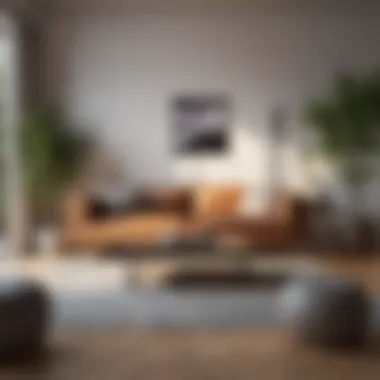Essential Steps to Begin Decluttering Your Space


Intro
Decluttering can often feel like a daunting task for many homeowners and individuals. Our spaces accumulate items over time, transforming from organized havens into chaotic repositories of belongings. Understanding where to begin can bridge the gap between aspiration and reality. This guide aims to provide insights into effective strategies for decluttering, highlighting the benefits of an organized environment while considering psychological and organizational elements.
The act of decluttering is not solely about removing excess items; it's also about creating functional spaces that reflect one's personal style and needs. Whether you aim to clear out your living room, tidy your kitchen, or organize a cluttered garage, certain principles remain consistent across all areas. This guide emphasizes actionable steps, practical tips, and engaging strategies that cater to various living environments and individual preferences.
Through a methodical approach, readers will discover how to tackle common decluttering challenges, promote positive psychological effects, and ultimately foster aesthetics that align with today’s design trends.
Understanding the Necessity of Decluttering
Decluttering is not merely about physical space; it encapsulates deeper personal and psychological dimensions. The need for decluttering arises when spaces become overwhelmed with unnecessary items. This can lead to feelings of chaos and anxiety, which affects one's overall well-being. When we discuss decluttering, it’s crucial to understand its necessity. It goes beyond aesthetic appeal and enters the realm of mental clarity and functional living. A clean, organized space can enhance productivity, reduce stress, and foster a sense of calm.
An environment filled with clutter can create a visual overload, which in turn may hamper one's ability to focus. This clutter is often a physical manifestation of our mental state. By addressing our spaces, we indirectly address our minds. In this article, we will explore the benefits of maintaining an organized space and how it contributes to a healthier lifestyle.
"A clutter-free environment equates to a clearer mind and a more productive life."
The psychological impacts of clutter can be profound. Studies show that individuals living in cluttered spaces often report higher levels of stress and discomfort. It creates not just physical barriers but emotional ones as well. By removing clutter, we can pave the way for a more positive atmosphere, allowing ourselves to breathe more freely in our own home.
Moreover, decluttering encourages intentionality. Each item that we choose to keep holds significance. This practice fosters mindfulness, making us consider what truly adds value to our lives. Understanding the necessity of decluttering helps solidify the motivations behind it, and these motivations guide your decluttering journey.
Engaging in decluttering can also enhance relationships with family and guests in your home. A tidy space invites warmth and togetherness, while clutter may lead to embarrassment or frustration during gatherings. Organizing your space truly transforms the dynamics of interaction, ensuring that your home remains a welcoming refuge.
As we progress through this guide, we will delve into various aspects, like the psychological impact of clutter and how to find motivations to declutter. Recognizing these areas will provide a foundational understanding, paving the way for practical steps to achieve a functional and pleasant environment.
Setting Realistic Decluttering Goals
Setting realistic decluttering goals is a critical step in the decluttering process. This section emphasizes how structured and well-thought-out objectives can make the process much smoother and more attainable. Without clear goals, it's easy to feel overwhelmed and frustrated. By defining specific targets, homeowners can establish focus and direction. These goals not only facilitate the decluttering journey but also help maintain motivation throughout the process.
One primary benefit of having defined goals is the ability to measure progress. When you know what you aim to achieve, it is simpler to assess how far you've come and what more needs to be done. This reflective practice instills a sense of accomplishment, which can be particularly beneficial when tackling large or daunting spaces.
Additionally, setting realistic goals fosters a more positive mindset. Rather than viewing decluttering as a chore, it can be reframed as a project with achievable milestones. This positive reframing is vital, especially for those who struggle with emotional attachments to their possessions.
Long-Term vs. Short-Term Goals
Deciding between long-term and short-term goals is essential for an effective decluttering strategy. Long-term goals, such as reducing overall clutter in your home within six months, provide a broad vision. These goals often require significant changes in habits and lifestyle, making them vital for sustainable clutter-free living.
On the other hand, short-term goals serve as stepping stones towards reaching larger objectives. For instance, a short-term goal could be to declutter one room within a week. These goals break down the overall task into manageable parts, making the process less intimidating. It’s beneficial to align both types of goals to create a comprehensive plan that encourages consistent progress.
Here are some examples of each type:
- Long-Term Goals:
- Short-Term Goals:
- Achieve a minimalist living space by the end of the year.
- Conduct a seasonal review of all belongings to maintain order.
- Spend 30 minutes a day decluttering a specific area.
- Sort through clothes before the next season starts.
Measuring Your Progress
Measuring progress is a significant part of maintaining motivation during the decluttering process. Implementing a system to track advancements can provide valuable insights into your decluttering journey. This can be as simple as keeping a journal or using mobile apps designed for organizing home spaces.
One effective method is to create a checklist of areas that need to be decluttered. As each area is completed, check it off. This visual representation of your progress can create a sense of achievement and encourage continued effort. Additionally, taking before-and-after photos can also serve as powerful reminders of how far you have come.
"Progress is progress, no matter how small"
This mantra is crucial to remember. Even minor increments towards your goal are steps in the right direction. Continuously assessing your progress allows adjustments to be made if necessary. Through this method, the decluttering journey becomes not just a task but a more manageable and rewarding experience.
Determining Areas to Declutter
Determining areas to declutter is a foundational step in the decluttering process. It allows individuals to focus their efforts efficiently rather than getting overwhelmed by the magnitude of clutter in their spaces. By identifying specific areas, one can tackle the decluttering process with intention and direction.
The importance of this section lies in its ability to break down the clutter into manageable segments. Clutter does not exist uniformly; it assembles in specific parts of a home, such as the living room, kitchen, or bedroom. Instead of trying to declutter everything at once, prioritizing the areas most in need of attention can yield quicker results.
Identifying the right areas helps homeowners feel accomplished, which can motivate them to continue. Success in one area naturally leads to a domino effect, encouraging further decluttering actions across the home. More so, this focused approach minimizes distractions and allows for a clear vision of what needs to be done.
Room-by-Room Approach
The room-by-room approach to decluttering provides a structured method for tackling clutter. This strategy promotes systematic progress by focusing on one room at a time, thereby reducing the likelihood of feeling overwhelmed. Each room holds its unique challenges and items that require attention.
Start with the most cluttered room or the one that causes the most frustration. For many, this may be the living room or home office. Clear visible surfaces first, such as tables and counters, because it creates instant gratification.
Here are steps to consider for each room:
- Bedroom: Start with your closet and drawers. Sort through clothing and shoes, deciding what to keep, donate, or throw away.
- Kitchen: Focus on cabinets and countertops. Eliminate expired food and appliances that are seldom used.
- Bathroom: Check cabinets for old products and medications. Ensure what you keep is useful and within expiry date.
By addressing each room individually, there is a better chance of maintaining focus and achieving results without simultaneous distractions from other spaces.
Identifying High-Traffic Areas
High-traffic areas, such as entryways and living rooms, typically accumulate clutter faster than other spaces. It is critical to identify and prioritize decluttering these areas because they can set the tone for overall home organization. A clean, functional entryway welcomes visitors and residents alike, making daily life smoother.
To tackle these spaces effectively, start by assessing how often they are used and if they reflect the purpose of the location. For example, the foyer should facilitate easy access to essentials like shoes and bags. If items are strewn about and there is no place to store them, this invites clutter.
Consider the following tips for managing high-traffic areas:
- Designate Zones: Assign specific zones for items that belong there. For example, create a shoe shelf or a hook for bags.
- Regularly Clean: Make it a habit to spend a few minutes each day tidying these areas to maintain order.
- Implement Storage Solutions: Use baskets or bins for items that do not have a designated home.
By focusing on high-traffic areas, the overall feeling of a home can shift drastically. A clear, organized space promotes positivity and operational efficiency in everyday life.
Effective Decluttering Strategies
Effective decluttering strategies form the backbone of achieving a tidy and organized space. This section emphasizes actionable methods that can transform not just physical spaces but also mental clarity. Employing right strategies can ease the process, leading to sustained benefits that extend beyond a one-off cleanout. By implementing structured approaches, clutter can be tackled in manageable increments, which reduces stress and increases productivity.
The Four-Box Method
The Four-Box Method is a practical system to streamline decision-making while decluttering. It categorizes items into four distinct boxes: Keep, Donate, Trash, and Unsure. Each category serves a specific purpose in promoting a clear focus for decision-making.
Keep


The Keep box is where you place items that you use regularly or that hold significant value in your life. One key characteristic of the Keep category is its emphasis on utility and importance. This choice is beneficial because it helps focus on the essential items. Additionally, keeping only what you truly need or cherish fosters a sense of ownership and satisfaction.
However, a unique challenge of the Keep category is the tendency to retain items based on emotional attachments rather than practical necessity. Making thoughtful decisions about what to keep can prevent clutter from building up again.
Donate
The Donate box is intended for items that are still in good condition but no longer serve a purpose in your life. The key aspect of Donate lies in its community impact, allowing others to benefit from the resources you no longer need. This option is favorable as it promotes a sense of altruism and social responsibility.
An important feature of donating is the ability to reduce waste effectively. By contributing to local charities or shelters, you share your items with those who can use them, which enhances the impact of your decluttering efforts. Nonetheless, some might find it emotionally challenging to part with items, questioning whether they might need them in the future.
Trash
The Trash box is straightforward; it is reserved for broken or unusable items that serve no further purpose. The key characteristic of this category is its simplicity, emphasizing the need for disposal. It is beneficial since it clears out genuinely unwanted materials that otherwise contribute to clutter.
A unique feature of using the Trash category is the potential for recycling. This allows you to dispose of items responsibly while still addressing the necessity to get rid of them. However, the risk is misunderstanding what truly belongs in the trash versus what might have reuse potential.
Unsure
The Unsure box is an important part of the Four-Box Method, catering to items that evoke uncertainty. This category acknowledges that not every decision is clear-cut. The key aspect of Unsure is that it gives space for reflection before making final decisions. Associated with this category is the opportunity to revisit these items later, enabling clearer judgments about their value.
A unique feature of this box is its flexibility, allowing you time to reconsider items without the pressure of immediate decision-making. However, a downside is the risk of holding onto items for too long, delaying the decluttering process, leading to potential additional clutter.
The / Rule
The 80/20 Rule suggests that 80% of our usage comes from 20% of our possessions. This principle underscores the importance of prioritization during decluttering. By focusing only on the items that provide the most value and practical use, homeowners can streamline their spaces. This method proves especially effective in identifying unnecessary clutter while emphasizing meaningful belongings.
In summary, understanding and employing effective decluttering strategies act as pivotal tools in crafting a clutter-free environment. Use these tactics to navigate the complex feelings surrounding possessions and their rightful place in your life.
Dealing with Sentimental Items
Dealing with sentimental items can be one of the most daunting tasks in the decluttering process. Many people struggle to let go of objects tied to personal memories or significant life events. This struggle often leads to excessive clutter, which can hinder emotional and physical space. Understanding how to address these items effectively is crucial for achieving an organized and comfortable living environment. It not only impacts physical space but also influences mental well-being.
Understanding Emotional Attachments
Emotional attachments to belongings are common. Items such as photographs, gifts, or heirlooms often evoke nostalgia or feelings of connection. These attachments can create a barrier to decluttering. The memories associated with each object can make it difficult to assess its actual utility or relevance to current life. Acknowledge that it is normal to feel tied to these possessions. However, it is important to find a balance between preserving memories and maintaining an organized space.
When evaluating emotional attachments, consider asking yourself:
- What does this item represent to me?
- Does it enhance my daily life or simply take up space?
- Am I keeping it out of obligation?
By reflecting on these questions, one can gain clarity and make more informed decisions about what to keep and what to part with.
Strategies for Parting with Precious Memories
Parting with precious memories does not have to be painful. Several strategies can help in this process:
- Create a Memory Box: Limit the number of sentimental items by choosing a single container where you can keep these treasures. This approach allows for preservation without overwhelming one’s space.
- Digitize Memories: For photos or documents, consider taking photographs or scanning them. Digital formats can be stored easily and do not require physical space.
- Practice the "One In, One Out" Rule: For each new keepsake or sentimentally important item brought into the home, consider letting go of one to maintain balance.
- Share with Loved Ones: Sometimes, sharing items with family or friends who may also appreciate their significance can ease the burden. This way, the emotional value is still honored.
- Focus on Experiences, Not Things: Try to remember the experiences linked to items, rather than the items themselves. Consider whether holding onto an object truly reflects the memory you cherish.
“The secret to letting go is realizing that some people are meant to be in your life but not with you.” - Anonymous
Incorporating these strategies can facilitate a smoother transition when it comes to sentimentally valuable possessions. Ultimately, the goal is to preserve meaning without allowing these items to accumulate to a point of overwhelm in your living environment.
Establishing a Decluttering Routine
Establishing a decluttering routine is crucial for maintaining an organized living space. A consistent routine ensures that clutter does not build up over time. This process is not merely about getting rid of unwanted items. It is about fostering a mindset that values simplicity and order. When you incorporate decluttering into your daily or weekly activities, it becomes a habit rather than a task that feels daunting.
The benefits of having a decluttering routine extend beyond mere aesthetics. A clean environment can contribute to improved mental clarity and reduced stress levels. Homeowners often find that spaces which are organized lead to enhanced productivity. Furthermore, a systematic approach helps in identifying clutter trends, providing insights into personal usage patterns.
Several considerations should be kept in mind when establishing this routine. First, recognize that decluttering is an ongoing process. You might initially succeed in one area only to find that clutter returns. This resurgence is normal and requires regular attention. Additionally, be mindful of your emotions as you declutter. Emotional attachments to certain items can lead to resistance. A clear routine allows for reflection and decision-making, which can ease the process of letting go.
Incorporating this aspect into your life will transform your home into a sanctuary that reflects intentionality and comfort.
Setting a Regular Schedule
Setting a regular schedule for decluttering activities is one of the most effective strategies for long-term organization. Consistency provides a framework within which you can operate, making decluttering less overwhelming. Start by allocating specific times during the week to tackle areas that require attention. It could be a simple 15-minute session each day or longer sessions on weekends. What matters most is the commitment to these appointments.
The schedule should also be flexible. Life can be unpredictable, and sometimes it might be necessary to adjust your plans. As long as you stay consistent with your intention to declutter, variations will not have a significant impact on your overall progress.
Developing this habit might take some time. However, as days turn into weeks and months, the benefits will become evident. You will start to notice less clutter and an improved state of mind due to the organized environment.
Creating a Maintenance Plan
Creating a maintenance plan is essential for sustaining a clutter-free home over time. This plan focuses on how you will manage incoming items to prevent clutter from accumulating. A crucial element of this plan involves evaluating any new possessions before you bring them into your space. Ask yourself questions such as: "Do I need this?" or "Will this add value to my life?"
Part of this maintenance plan includes regular reviews of your surroundings. Set aside monthly or quarterly time slots to reassess your belongings. During these reviews, ensure that items still serve a purpose. If you discover things that are no longer applicable, take action by either donating or disposing of them.
Additionally, having a dedicated place for everything can significantly aid in maintaining order. When items have assigned locations, it becomes easier to keep track of them. You may also implement a one-in-one-out rule—every time you bring in a new item, let go of another. This discipline promotes a balance that helps keep clutter at bay. Having a structured maintenance plan can significantly contribute to the overall health of your living space.
Maintaining a Clutter-Free Environment
Maintaining a clutter-free environment is a critical aspect of effective decluttering. It goes beyond the initial process of sorting through belongings. This topic emphasizes the ongoing effort required to keep one's space organized and serene. A clutter-free home contributes significantly to mental clarity, emotional well-being, and overall productivity. When spaces are kept tidy, individuals are likely to experience less stress. It fosters a sense of control over one's surroundings.
Benefits of a Clutter-Free Environment:
- Improved Focus: A clear environment allows for greater concentration. It minimizes distractions that clutter often creates.
- Enhanced Aesthetics: Space that is organized looks more inviting. This establishes a calmer atmosphere for both residents and guests.
- Efficiency: When items are in their designated places, time spent searching for things is reduced. This leads to a smoother daily routine.
- Better Hygiene: Fewer items mean less dust and dirt accumulation, which contributes to a healthier living space.
Maintaining this environment requires a commitment to consistency. It is not a one-time task but rather an ongoing lifestyle change. Regularly reassessing and tidying spaces helps to anchor new habits.
Incorporating Minimalist Principles
Embracing minimalist principles can significantly aid in maintaining a clutter-free environment. Minimalism encourages ownership of only what you truly need and value.
Key principles of minimalism include:
- Intentionality: Consider each item's purpose in your living space. Keep only those items that serve a clear function or bring joy.
- Less is More: Aim for a streamlined space. Fewer items can lead to easier maintenance.
- Quality Over Quantity: Invest in fewer, high-quality items rather than a larger collection of lower-quality ones. This approach tends to reduce clutter in the long run.


Practical Steps to Incorporate Minimalism:
- Assess Your Belongings: Evaluate each item honestly. Determine its relevance and necessity.
- Set Limits: Specify how many of certain items you will keep. For instance, limit the number of decorative pieces in a room.
- Regular Purges: Schedule consistent periods for decluttering. This could be monthly or seasonal—however it fits into your routine.
- Mindful Shopping: Be discerning when acquiring new items. Ask yourself if they align with your minimalist goals.
Continuous Evaluation and Adaptation
Continuous evaluation and adaptation are vital for sustaining a clutter-free environment. The original decluttering process lays a foundation. However, life events and changes affect how space is utilized. Regular assessment ensures that the living area aligns with current needs and preferences.
Considerations for ongoing evaluation include:
- Routine Check-ins: Regularly dedicate time to review spaces. This can be as simple as a weekly walkthrough to identify clutter build-up.
- Adaptation to Life Changes: Consider how changes in household dynamics—such as children growing up or moving in—might affect your belongings.
- Adapting Storage Solutions: As needs evolve, so should storage methods. Explore different organizing tools or furniture.
"Clutter is the physical manifestation of unmade decisions fueled by procrastination."
To Effectively Adapt Over Time:
- Maintain a flexible mindset, allowing for changes in decor or lifestyle.
- Use simple tools like lists or mobile apps for inventory control.
- Encourage feedback from family or housemates regarding shared spaces.
In summary, maintaining a clutter-free environment requires a blend of minimalism and continuous evaluation. By committing to these practices, it’s possible to create and sustain an organized, tranquil space conducive to both productivity and relaxation.
Utilizing Technology in Decluttering
Technology has emerged as a pivotal ally in the journey of decluttering. The importance of utilizing technology in decluttering lies in its ability to provide tools that streamline the process and make it more enjoyable. Many people find themselves overwhelmed by the physical act of decluttering, but the integration of technology can simplify tasks, promote organization, and enhance motivation. In this digital age, one can leverage a plethora of applications and online resources to aid in reducing clutter effectively and efficiently.
Benefits include:
- Efficiency: Technology allows for quicker sorting, organization, and even disposal of items.
- Accessibility: Many tools are available on smartphones and tablets, making them easy to access wherever you are.
- Support: Various apps provide reminders and motivational prompts, helping to maintain the decluttering momentum.
When considering technology, homeowners and design enthusiasts should think critically about how these tools can adapt to their individual needs. It is essential to select applications that resonate with one's personal decluttering style and goals.
Mobile Apps for Organization
Mobile apps have revolutionized how we approach organization. With just a few taps on your smartphone, you can manage your space more effectively. Numerous apps provide features specifically designed for decluttering, enabling users to sort, track, and donate or sell items.
Some popular apps include:
- Decluttr: This app helps you sell unwanted electronics while ensuring safe processing.
- Letgo: A popular choice for selling products quickly in local markets.
- Goodbye Junk: This app can generate a plan to remove unnecessary items efficiently.
Using mobile apps allows declutterers to utilize their time better. Keep track of progress over time, and many apps have a user-friendly interface that appeals to tech-savvy individuals. Moreover, reminders sent through these apps can help you stay on track, provide motivation, and ultimately make decluttering less daunting.
Online Donations and Selling Platforms
The online marketplace for donations and sales provides an extensive network for homeowners looking to lighten their load. Platforms like eBay, Facebook Marketplace, and OfferUp allow individuals to sell unwanted items quickly.
Benefits of using online platforms include:
- Wider Reach: Selling online connects you to a larger audience than a garage sale.
- Flexibility in Pricing: Many platforms allow you to negotiate prices, making it simpler to sell items without the pressure to set fixed prices.
- Convenient Donations: Websites dedicated to donations can often arrange pickups, removing the necessity for you to transport items.
The decision to utilize these platforms often hinges on the item type and condition. If an item is in good condition and can be valuable to others, selling it can be an optimal route. On the other hand, for items that may not hold considerable value, donations lend a sense of social responsibility while aiding those in need.
In summary, employing technology for decluttering presents multiple avenues for efficient organization and disposal. The intersection of our physical and digital worlds can aid in maintaining a clutter-free environment, enhancing both function and aesthetics in our homes.
Engaging Family and Housemates
Involving family members and housemates in the decluttering process significantly amplifies the likelihood of successful outcomes. When multiple people share a living space, clutter often accumulates from everyone's habits. Thus, fostering a collaborative environment is essential. Not only does it lighten the burden of cleaning and organizing, but it also cultivates unity and shared responsibility. There are specific elements that enhance this engagement:
- Shared Goals: Everyone involved should understand the objective. This could be as simple as creating a more serene home environment or preparing for a community event.
- Open Communication: Discuss preferences on what to keep and what to let go. This helps in minimizing misunderstandings.
- Team Spirit: Create a sense of camaraderie by working together. It can turn a tedious task into a more enjoyable experience, reducing resistance.
Benefits of engaging family and housemates range from enhanced motivation to saving time. When responsibilities are shared, tasks can be completed faster and more efficiently. Moreover, it allows for diverse perspectives on what to keep or discard, leading to a more balanced decluttering plan. Everyone feels heard and valued.
"When we all pitch in, we create not just a cleaner space, but a stronger bond among us. "
Collaborative Decluttering Sessions
Organizing collaborative decluttering sessions can effectively ensure the vivacity of the decluttering experience. These sessions should be structured but flexible, accommodating everyone’s schedule. Set specific times for these group activities to establish commitments. Additionally, consider the following aspects:
- Setting the Tone: Create an inviting atmosphere. Provide snacks and start with a casual discussion about the benefits of decluttering.
- Strategic Planning: Designate areas of focus beforehand. Working on one room or category at a time can enhance efficiency.
- Encouragement and Support: First-timers may find it daunting. Offer reassurance and positive reinforcement; it fosters an encouraging environment.
Such sessions should be fun and productive. Breaking the monotony turns a tedious task into an enjoyable event. It is essential to focus on teamwork while maintaining a lively spirit.
Assigning Decluttering Tasks
Assigning specific tasks to each family member or housemate can streamline the decluttering process. By clearly designating responsibilities, everyone knows what is expected, reducing confusion. Here are effective ways to assign tasks:
- Assess Individual Strengths: Each person may have different strengths. Understand who excels at particular tasks, such as sorting or cleaning.
- Categorize: Break down the decluttering process into categories. Assign areas like clothing, books, or kitchen items to different individuals to avoid overlap.
- Set Realistic Expectations: Ensure tasks assigned are manageable. This will avoid overwhelming anyone, resulting in a higher completion rate.
Clear task assignments can foster accountability. When each person has specific duties, the chances of completion increase. Additionally, it eliminates the problem of having one person do all the work, which can lead to resentment.
Adapting Decluttering for Different Living Spaces
When it comes to decluttering, one size does not fit all. Each living space presents its own unique challenges and opportunities. For homeowners and renters alike, understanding how to adapt decluttering methods based on the size and nature of the living area is essential. Not only does this improve functionality, but it also creates an aesthetically pleasing environment.
Factors to consider include available space, personal lifestyle, and the type of belongings that need organizing. Tailoring techniques ensures that the decluttering process is effective and sustainable, making it easier to maintain a clutter-free environment.
Small Apartments
Small apartments often require a strategic approach to decluttering. Space is limited, demanding thoughtful curation of items that reflect both utility and sentiment. Maximizing vertical space is crucial. Shelving and wall mounts can easily transform unused areas into storage opportunities.
- Multi-Functional Furniture: Consider using pieces that serve multiple purposes. A coffee table that doubles as storage can save space while offering functionality.
- Use Under-Bed Storage: The area under the bed is often neglected. Utilize containers to store seasonal clothing or rarely used items.
- Create Zones: Divide your apartment into specific areas for different activities. Assign distinct places for work, relaxation, and hobbies to prevent clutter from accumulating.
Engaging in a regular review of possessions helps maintain an organized space. Items that are not essential or contributing positively should be considered for donation or disposal.
Larger Homes
Larger homes provide more room, yet can also contribute to the risk of clutter accumulation. Here, the key lies in adopting systems that can efficiently handle the excess space.


- Room-by-Room Approach: Focus on one room at a time rather than overwhelming yourself with the entire house. This can lead to a more manageable and satisfying decluttering process.
- Dedicated Storage Solutions: Implement storage solutions such as cabinets and closets tailored for functionality. It is also practical to consider different categories for belongings, such as holiday decorations, clothing, and hobby materials.
- Seasonal Decluttering: Larger homes can benefit from seasonal reviews, adjusting possessions with changing seasons. Items used regularly can be stored in accessible locations, while others can be tucked away.
> "Keeping spaces clear can foster a sense of calmness and organization, enhancing one's overall quality of life."
In summary, adapting decluttering practices to fit the unique needs of different living spaces enhances the experience and yields better results. Small apartments demand creativity and efficiency while larger homes call for systematic organization. Each space can become a sanctuary of order with the right strategies.
The Role of Decluttering in Environmental Sustainability
In today's society, where consumerism is prevalent, the impact of our possessions cannot be ignored. The role of decluttering extends beyond merely creating space in our homes. It directly relates to environmental sustainability, making it a crucial aspect of any decluttering process. Understanding how our actions contribute to environmental degradation helps in making informed decisions while sorting through items. Reducing clutter not only benefits individual living circumstances but also contributes positively to the planet.
Reducing Waste Through Responsible Disposal
Responsible disposal is vital in the decluttering process. Many items that we consider waste can be repurposed, recycled, or given a second life through donation. When you declutter, prioritize where your items will end up. Avoid landfills, which contribute to environmental damage. Instead, consider these options:
- Donate: Many organizations accept gently used items, ensuring they get a new home.
- Recycle: Research local recycling programs to dispose of items like electronics and paper products correctly.
- Repurpose: Find creative ways to utilize items instead of discarding them. Old jars can become storage containers, or worn clothes can be transformed into cleaning rags.
By minimizing what goes to waste, you actively participate in reducing the overall carbon footprint associated with manufacturing new products. This approach cultivates a mindset of sustainability in your daily life.
Promoting Sustainable Practices in Home Management
Integrating sustainable practices in home management is crucial as we embrace decluttering. When you adopt a more minimalistic lifestyle, you naturally steer clear of excessive consumption. Developing habits that emphasize sustainability can lead to significant long-term changes. Consider the following practices:
- Mindful Purchasing: Prioritize quality over quantity. Invest in items that last longer and fulfill specific needs.
- Conscious Consumption: Avoid accumulating things out of habit. Ask yourself if an item truly adds value before bringing it into your home.
- Home Energy Efficiency: Evaluate your energy use and make small changes like using energy-efficient bulbs or smart thermostats, which complement a clutter-free environment.
By promoting these sustainable practices, you can create an eco-friendly home while decluttering. Not only do these actions contribute to a cleaner environment, but they also inspire others in your community to take similar steps, fostering a collective effort toward sustainability.
"The environmental impact of decluttering is significant. Each item you choose to recycle or donate makes a difference."
Learning from Case Studies
Understanding the journey of others can provide valuable insights into the decluttering process. Learning from case studies allows individuals to grasp the complexities involved in tackling clutter effectively. Each story comes with lessons that can shorten the learning curve for newcomers to decluttering or those who have struggled in the past. Case studies highlight various methods that worked for others and the mistakes to avoid, making them a useful resource in one's decluttering journey.
When evaluating these case studies, focus on elements such as prior conditions, strategies employed, and outcomes achieved. Moreover, emotional aspects are often intertwined with physical clutter. By immersing oneself in different experiences, homeowners and design enthusiasts can draw personalized conclusions that resonate with their unique situations. This method can facilitate a more organized and clutter-free living environment.
"People learn from their successes and failures, but by examining the successes and failures of others, we can make more informed decisions on our own paths."
Successful Decluttering Experiences
Successful decluttering experiences offer a roadmap for individuals embarking on their own journey. Many who have achieved significant results share that the initial step was identifying the root causes of their clutter. By recognizing specific habits or lifestyle choices that contribute to disorganization, individuals can more effectively formulate a plan.
For instance, consider a busy professional. This individual may have clutter due to a lack of time to organize. In learning from others in similar situations, they can adapt time-saving strategies. Techniques such as setting aside just ten minutes daily for decluttering can lead to substantial progress over time.
Furthermore, sharing successful experiences often involves highlighting practical methods. For example, using the Four-Box Method can lead to rapid decision-making. Many find that having clear categories for keep, donate, trash, and unsure reduces the stress associated with decision-making.
Lessons Learned from Failures
While success is motivating, learning from failures can be equally instructive. Individuals often discover that unrealistic expectations hinder progress. Many may attempt large, sweeping decluttering sessions only to become overwhelmed and abandon the effort. Realizing that decluttering is a gradual process is crucial.
Some common lessons include:
- Overcommitting Time: Individuals often miscalculate how long the decluttering process will take, leading to frustration.
- Emotional Attachments: Failing to confront the emotional ties to certain items can result in unfinished decluttering tasks.
- Ignoring Maintenance: Once clutter is cleared, neglecting ongoing organizational practices can allow it to return.
Draw insights from these failures to cultivate a more sustainable decluttering approach. Accept that obstacles are part of the journey. By understanding the pitfalls faced by others, one can navigate their own decluttering path with greater awareness and determination.
Exploring Professional Decluttering Services
In the realm of decluttering, many individuals find themselves at a crossroads—torn between the desire for an organized space and the overwhelming nature of the task itself. This is where professional decluttering services come into play. These services not only provide expertise and support but also mitigate the emotional burden that often accompanies the process of reevaluating personal possessions. For homeowners, those engaged in interior design, and anyone inclined towards keeping their spaces tidy, understanding the role of these professionals is increasingly relevant.
Benefits of Professional Help
Professionals bring a wealth of experience to the table, often utilizing methods and techniques that clients may not have considered. They can assess the clutter and create a structured plan tailored to individual needs. Additionally, professional services can help clients detach emotionally from items that may be causing unnecessary clutter. This emotional assistance is particularly vital for those struggling with sentimentality or indecision regarding valuable items.
When to Hire a Professional
Determining when to engage a professional decluttering service can be challenging. It is essential to consider several factors:
- if the task feels insurmountable, and personal efforts have failed.
- when emotional attachment to items interferes with the ability to declutter effectively.
- if there is a significant life event approaching, such as moving or a family change.
- when time is of the essence, and efficiencies in decluttering could lead to quicker results.
Seeking professional assistance can be an act of self-care, reflecting a commitment to personal space and mental clarity.
Costs and Benefits of Professional Help
The cost of hiring a professional declutterer can vary widely based on service scope and local market conditions. Many firms offer packages that include hourly rates, flat fees for specific projects, or ongoing consultations. It is important to consider the following potential benefits against the investment required:
- Efficiency: Professionals can often clear spaces faster than those who may be inexperienced in tackling clutter.
- Expertise: They provide specific strategies tailored to the client's lifestyle and space constraints, ensuring sustainability.
- Less Stress: Professional support can alleviate the anxiety that often accompanies decluttering decisions, allowing clients to focus on other priorities.
- Increased Space: A decluttered environment naturally leads to more usable space, which can be transformed for new purposes, like home offices or guest rooms.
While the initial cost might seem high, the long-term benefits of a well-organized and serene space can justify the expense. Ultimately, whether to engage professional help hinges on individual circumstances and the specific challenges one faces in the decluttering journey.
Future Trends in Decluttering
In the ever-evolving landscape of home organization, understanding future trends in decluttering becomes increasingly essential. This section examines contemporary approaches and shifts in mindset around decluttering. The emphasis on practicality, psychological well-being, and environmental sustainability are critical elements that influence how individuals and families tackle clutter.
Decluttering in the Digital Age
The digital age has profoundly altered our relationship with belongings and information. As technology advances, the focus often shifts to virtual decluttering in addition to physical spaces. Managing digital clutter is as important as dealing with physical items. E-mails, files, and applications can accumulate rapidly, creating stress in our digital lives.
Some effective strategies to manage digital decluttering include:
- Regularly Organizing Files: Set a routine, like weekly or monthly, to sort and delete unnecessary files.
- Email Management: Unsubscribe from newsletters and promotional emails that are no longer of interest. Use folders to categorize important messages.
- Utilization of Cloud Services: Implement cloud storage options like Google Drive or Dropbox to clear space from physical devices while keeping access straightforward.
Technology allows people to go beyond traditional decluttering methods, combining them with various apps designed to streamline organization efforts. These resources not only facilitate ease of access but also keep digital information tidy and manageable.
Emerging Philosophies and Practices
Philosophical approaches to decluttering are expanding to encompass more than just tidiness. A growing awareness of minimalism, mindfulness, and intentional living shapes how individuals view their belongings. Minimalism advocates for living with less, prioritizing experiences over possessions. Mindfulness emphasizes the importance of being present and making thoughtful decisions about what to keep or discard.
Key practices emerging in this domain include:
- Intentional Purchasing: Before making a buy, consider if the item adds value to your life. This reduces future clutter by discouraging impulse purchases.
- The Joy Factor: Inspired by Marie Kondo, the practice of keeping items that spark joy fosters emotional connections to belongings, prompting individuals to evaluate their choices with care.
- Sustainable Decluttering: Responsible disposal methods, such as recycling or donating, are becoming more prevalent. This not only benefits the environment but also enhances the sense of fulfillment by giving items a new life.
"Decluttering is about making conscious choices, not just throwing things away. It’s an opportunity to reflect on what matters most in life."
By combining these philosophies with practical methods, individuals can achieve not only a cleaner space but also a more meaningful environment. As we move forward, these trends will likely shape how decluttering is perceived and executed, resonating deeply among homeowners, interior design enthusiasts, and others looking to establish a clutter-free lifestyle.















